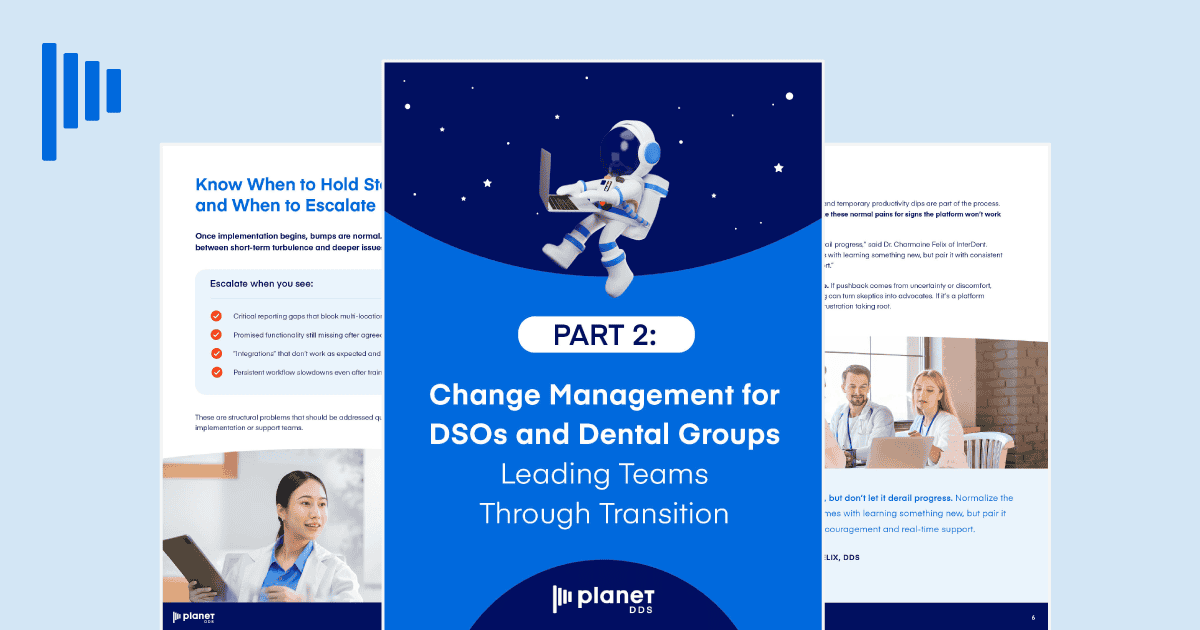Change Management for DSOs and Dental Groups: Leading Teams Through Transition

Change management is where technology investments prove their value. A new practice management platform can open the door to stronger operations and better patient experiences, but success depends on what happens after the decision is made. For DSOs and dental groups, the challenge lies in supporting teams through change with steady leadership, clear communication, and ongoing guidance.
Part 2: Change Management for DSOs and Dental Leading Teams Through Transition explores the realities of post-sale change management, including how to strengthen team buy-in, when to escalate challenges, and the value of bringing in outside expertise. Learn from industry experts and get effective change strategies to create smoother transitions and stronger adoption.
How to Lead Your Team Through Change
Effective transitions start with a clear purpose. When leaders explain the why behind a system shift, they create alignment before the technical work begins.
As teams connect their daily work to a larger purpose, adoption accelerates. Without that clarity, rollouts often stall, leading to stress and frustration.
Leaders can strengthen transitions by:
- Explaining the purpose early and often
- Connecting daily work to larger goals
- Encouraging open conversations across roles
“One of the first things we do is understand everyone’s ‘why’ starting with leadership and extending out to each doctor and office manager. Taking time for these conversations makes the transition smoother and accelerates adoption across the organization.” —Jill Nesbitt, Founder, Optimize Dental Consulting
When to Hold Steady and When to Escalate
Every rollout comes with obstacles. The challenge for leaders is distinguishing normal turbulence from deeper structural issues.
Escalation makes sense when reporting gaps limit visibility, promised features remain unfinished, or integrations disrupt workflows. By contrast, early resistance, temporary productivity dips, and the normal learning curve are expected and often resolve with time and support.
When escalation makes sense:
- Reporting gaps limit visibility
- Promised features remain unfinished
- Integrations disrupt workflows
- Persistent workflow slowdowns continue after training
“Expect resistance, but don’t let it derail progress. Normalize the frustration that comes with learning something new, but pair it with consistent encouragement and real-time support.” —Dr. Charmaine Felix, InterDent
Prioritizing Your Team Members First
Technology adoption is always a people-first effort. Each role within the organization views the transition differently. Dentists may look for streamlined charting, operations leaders want stronger reporting, and front-office staff value less repetitive data entry.
Strong adoption comes from trust, reinforced by role-specific wins, visible champions in each practice, and celebrating milestones as teams adapt.
Ways to strengthen buy-in:
- Share role-specific wins that show tangible benefits
- Keep the “why” visible in every meeting and update
- Identify and empower champions in each practice
- Celebrate small milestones post go-live
“Never say that nothing is going to change. Be upfront with people and acknowledge the feelings they’re having so you can work together to address their concerns.” —Kara Trail, Director of Operations, Henritze Dental Group
Preparing Your Pre-Conversion Checklist
The preparation done before go-live often determines how smoothly the first ninety days unfold.
Essentials to prepare in advance:
- Test data mapping and migrations in advance.
- Assign location-level go-live leads.
- Plan patient communication early.
- Clean data before migration.
“The key is preparation: It’s accurate auditing so you know what will convert as expected, accurate fee schedules loaded, accurate provider information, and accurate data mapping. That’s the foundation.” —Pamela Holder, Chief Strategy Officer, Advanced Dental Brand
Training and Implementation Best Practices
Training works best when it’s role-based, reinforced with feedback, and introduced gradually. Teams benefit from early demos, real patient scenarios, and lighter schedules during the first few days after go-live. Leadership presence—showing up in practices and acknowledging challenges—helps ease anxiety and ensures teams stay engaged.
Best practices for smoother adoption:
- Start with early demos and real patient scenarios
- Mix live and recorded training formats
- Allow lighter schedules during the first days post go-live
- Maintain feedback loops to adjust quickly
“I always tell the teams to not over-fill their schedule on the go-live day. Give yourself a little extra time to get used to the new workflow.” —Etta Bourne, VP of Systems Integrations, Premier Care Dental Management
When to Bring in an Outside Consultant
Some DSOs benefit from additional expertise, particularly when internal resources are stretched or offices are unifying after rapid expansion. Consultants bring structure, provide role-based workflows, and offer outside perspective when challenges arise.
Consultants can provide support:
- Before go-live, to strengthen planning
- Mid-implementation, if adoption stalls
- Post-go-live, to refine workflows and measure results
“The right time to bring in a consultant is when the internal team doesn’t have the bandwidth or the experience to manage the change, and when there’s a big enough business problem that it’s worth solving well.” —Jill Nesbitt, Optimize Dental Consulting
How Planet DDS Partners to Manage Change
Planet DDS builds change management directly into our onboarding framework. From kickoff to post-launch, the process focuses on creating clarity, embedding proven workflows, and providing leadership resources.
Core elements include:
- Kickoff and alignment with expectation-setting
- Early office selection with strong leadership
- Role-based, phased training supported by surveys
- Leadership messaging and communication resources
- Post-launch reviews that feed into playbooks and training
“It’s rewarding to watch how effective change management can transform a rollout. We see higher adoption rates and happier teams.” —Molly Gapp, VP of Professional Services, Planet DDS
Leading the Change Process
Post-sale change management is where technology investments prove their value. DSOs that prioritize their teams, prepare deliberately, and approach implementation with empathy are best positioned to succeed.
To lead change more effectively:
- Put people at the center of adoption
- Prepare deliberately before implementation begins
- Lead with empathy to build trust across teams
Planet DDS has helped hundreds of organizations manage these transitions with Denticon and expert onboarding teams. With the right strategy, change strengthens both operations and team culture.
Guide Your Team Through Change
Transitions don’t have to derail productivity or morale. With the right planning and support, they become opportunities to build stronger teams, create trust, and achieve measurable improvements. DSOs that focus on people, structure, and communication throughout implementation will see adoption take hold faster and with greater long-term impact.
Wanting to get more tips about change management before implementation begins? Check out: Part 1: Change Management for DSOs and Dental Groups: Laying the Groundwork
Looking for solutions to guide your teams through change? Contact us today.



